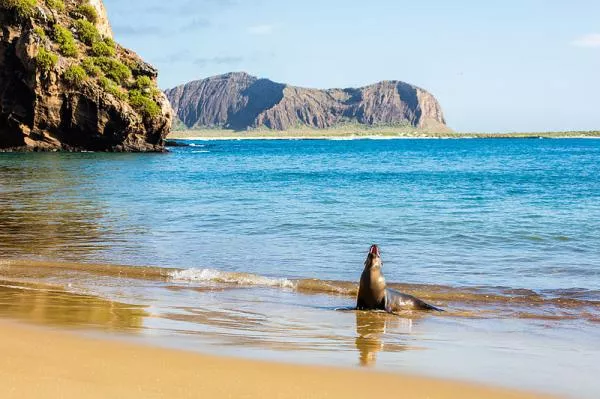
The Galapagos Islands, also known as the Enchanted Islands, are one of the biodiversity paradises most admired by all nature lovers. Who has not dreamed of seeing the giant tortoises or finches described by Darwin during his scientific expeditions?
Also known as the "living laboratory", the Galapagos Islands continue to discover new species and make surprising discoveries in the characteristics of the flora and fauna that make up their ecosystems. For this reason, the Galapagos archipelago has numerous initiatives to protect and preserve its most precious asset: its wonderful biodiversity.
Continue reading this Green Ecologist article in which you will discover incredible species of the flora and fauna of the Galapagos Islands.
Characteristics of the Galapagos Islands
The Galapagos Islands were declared World Heritage by UNESCO in 1978. This archipelago located in the Pacific Ocean, 1000 kilometers from the coast of Ecuador, is made up of 13 large islands, 6 medium ones and 215 small islets.
Their volcanic islands They are home to more than 500 species of native plants (those that are native to this region, in which they have grown and evolved) and 180 species of animals that are endemic, unique to this corner of the planet.
We can find species of animals and plants in the coastal and arid areas of the islands, as well as in wetlands and pampas. These diverse ecosystems are fragile, as they suffer the negative effects of climate change and many human actions that harm their flora and fauna.
Next, we discover the endemic species of the Galapagos Islands

Flora of the Galapagos Islands
Among the flora of the place, that is, the endemic plants of the Galapagos Islands, we find:
Cactaceae of the Galapagos Islands
Among the cacti that we can find in the arid regions of the islands appears the candelabra cactus (Thouarsii jasminocereus). It reaches up to seven meters in height and is shaped like a tube with thorns. The lava cactus also stands out (Nesioticus brachycereus), considered the smallest cactus species that inhabits the Galapagos Islands.
Other plants of the Galapagos Islands
- Darwin's cotton (genus Gossypiumdarwinii).
- The bushes of (Robinsoniana miconia), which form a dense belt in humid areas.
- The endemic daisy (Pinnatifidus lecocarpus) that grows in areas of lava or ash.
- The Galapagos tomato (Solanum cheesmaniae).
- The little bush called Lantana peduncularis of white and yellow flowers.
In these images below you can see the endemic plants of the Galapagos Islands in the order in which we have mentioned them.


Galapagos Islands fauna
We can find species of animals of the Galapagos Islands that are endemic within the different groups of animals that inhabit the three natural environments of the islands: land, fresh water and ocean.
Let's put some examples to learn more about these animals that we can exclusively find on these islands in the Pacific Ocean.
Endemic mammals of the Galapagos Islands
Many of the mammals that we can find today in the Galapagos Islands have been introduced by man. However, we can still find some endemic species of the Galapagos Islands, among which stand:
The Galapagos sea lion or sea lion (Zalophus wollebaeki), with a total population of up to 50,000 specimens that inhabit the volcanic coasts of the archipelago; and the fur wolves of the Galapagos or Galapagos fur seals (Arctocephalus galapagoensis), nocturnal animals that feed in deep waters and generally do not migrate.

Birds of the Galapagos Islands
Immersing ourselves in the wonderful world of birds, we will find numerous endemic bird species of the Galapagos such as the cormorant mancón (Phalacrocorax harrisi), unusual bird that has lost the ability to fly; as well as the penguin or booby bird of the Galapagos (Spheniscus mendiculus), the only penguin species that can be found living in the wild in the Northern Hemisphere. Find out more about these animals in this other Green Ecologist article on Where penguins live and what they eat.
Also noteworthy are the thirteen endemic species of Darwin's finches, as well as the brown pelican (Pelecanus occidentalis urinator) and the Galápagos short-eared owl (Asio flammeus galapagoensis).

Reptiles that only live on the Galapagos Islands
Perhaps it is the Galapagos tortoises (genus Chelonoidis) the most representative reptiles of the Galapagos archipelago, but let's get to know more examples of its emblematic reptiles.
Within the group of iguanas, we find the marine iguana (Amblyrhynchus cristatus), the only species of iguana in the world that obtains its food from the sea and the land iguana (genus Conolophus), which feeds on cacti in arid areas. They are very striking because of the bright colors of their skin and because they are able to stay on their hind legs to reach flowers that are higher than the ground.
The lava lizardMicrolophus albemarlensis) is smaller in size, with bright red and orange colors on its chest.

Endemic fish of the Galapagos
There are some 86 varieties of endemic fish (ichthyological fauna) that inhabit the waters of the Galapagos Islands.
Among the cartilaginous fish the cat shark stands out (Bythaelurus giddingsi), a species that was discovered in 2012, so very little is still known about it.
If you liked these unique species of flora and fauna of the Galapagos IslandsYou may also want to discover the Flora and fauna of the Falkland Islands.
 Image: Grist
Image: Grist
If you want to read more articles similar to Flora and fauna of the Galapagos Islands, we recommend that you enter our Ecosystems category.
Bibliography- E. Ayala (1995). New history of Ecuador: documents of the history of Ecuador. National Publishing Corporation.
- A biodiversity vision for the Galapagos Islands. Darwin Foundation, pp: 136-138.
- Conservation and restoration of island ecosystems (2010). Ministry of the Environment, Galapagos Islands, Ecuador.
- In Galapagos the endemic flora is recovered. Trade (2022).


